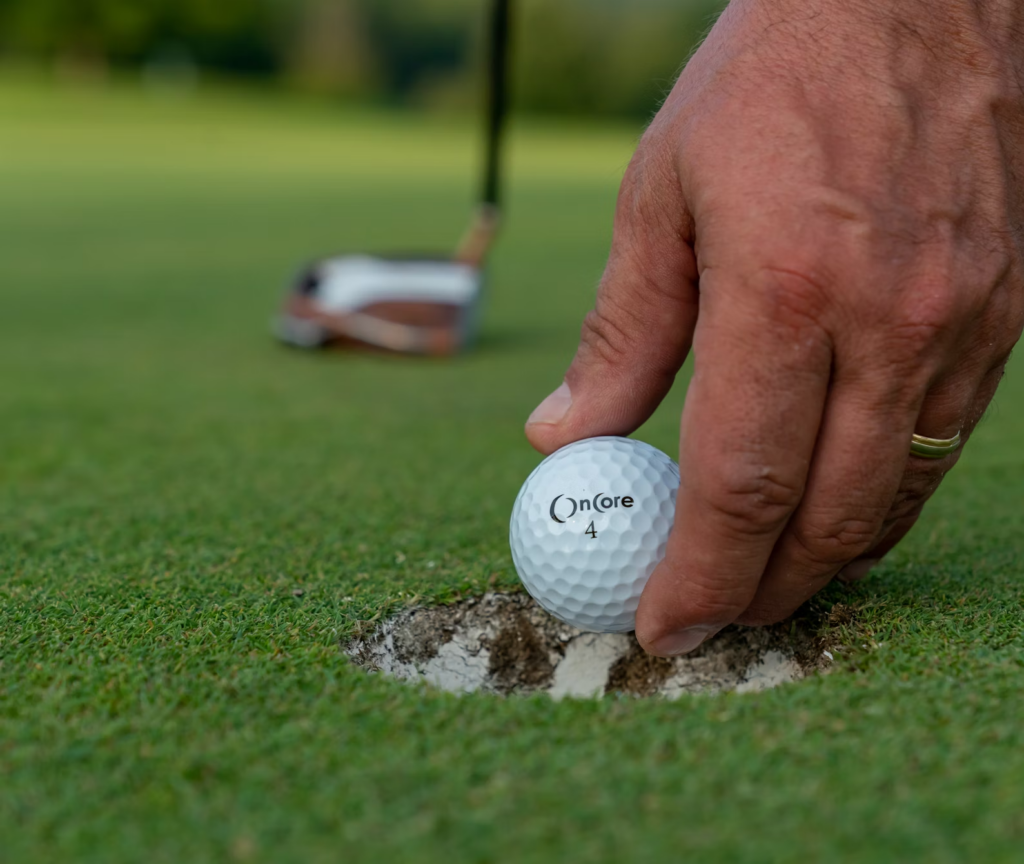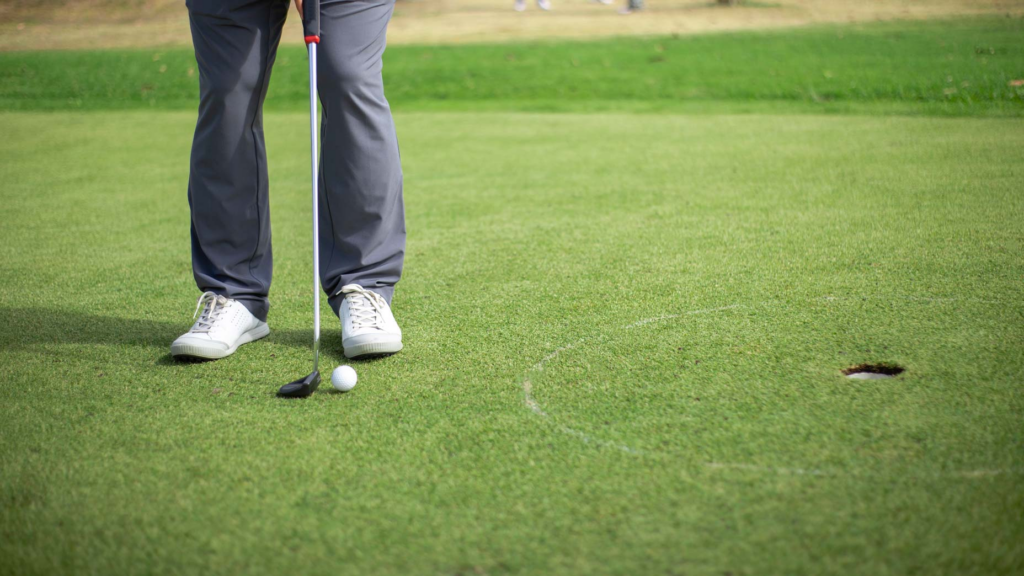Adapting or adjusting to the putting green on your first golf round on a new course is akin to a rite of passage for golfers. Mastering the green speed and understanding the nuanced interplay between weather conditions and green speed can significantly enhance your performance. This comprehensive guide aims to equip you with the essential knowledge and strategies to confidently tackle new greens, starting with identifying green speed and exploring the weather’s impact on it.

Understanding Green Speed
Determining whether a golf green is slow or fast can significantly affect your play, and there are several methods to gauge this. One common method involves using a Stimpmeter, which rolls a ball at a controlled speed across the green to measure the distance it travels in feet. This distance indicates the green’s speed: longer distances mean faster greens, and shorter distances indicate slower greens. Greens averaging around 10 feet or beyond are considered fast, common in professional tournaments, while those below 8 feet are deemed slow.
For a practical approach, spend some time on the practice green before your round. Observe how far your putts roll compared to your expectations. This can give you a good sense of whether the greens are faster or slower on that day. A few long putts should be enough to gauge the green speed effectively. Additionally, practicing putts from different distances, especially 15-foot putts, can help you adjust your stroke based on whether your ball consistently comes up short or goes past the hole.
Other factors to consider include the slope and moisture of the greens, which can affect speed. Steeper slopes result in faster ball rolls downhill, while moisture can slow down the greens. Feeling the green with your feet and paying attention to these aspects during a few practice strokes can also provide valuable insights into the green’s speed. This method helps in adjusting your aim and stroke accordingly.
In summary, understanding green speed is crucial for optimizing your putting and overall play. Whether you’re using a Stimpmeter or simply practicing on the green before your game, accurately assessing green speed can help you make more accurate putts and improve your performance on the course.
The Weather and Green Speed Relationship
Weather conditions play a pivotal role in influencing green speed. Factors such as humidity, temperature, rainfall, and even the time of day can alter how fast or slow the green plays. For instance, greens tend to be slower in damp or wet conditions as the moisture increases friction between the ball and the turf. Conversely, dry and hot conditions can make the greens faster, reducing the resistance against the ball’s roll.
- Humidity and Dew: Morning dew and humidity can make greens slower due to increased resistance.
- Temperature Fluctuations: Warm conditions can firm up the greens, making them faster, while cold may slow them down.
- Rainfall: Recent rain can significantly slow down greens by increasing friction.
- Wind: Wind can affect the moisture level on the green’s surface and, thus, its speed.

Adapting to Green Speed on a New Course
Adapting to green speed on a new course is a multifaceted skill that encompasses several strategies. Understanding and adjusting to green speed is not just about practice; it’s about developing a nuanced approach that considers various factors from physical adjustments in your putting stroke to psychological readiness. Here’s a deeper dive into how you can adeptly adapt to green speed on a new course:
Pre-Round Preparation
Observation and Analysis
Start with observing the greens before your round. Look for golfers who are already playing and pay attention to how their balls behave on the green. Notice if the balls are rolling faster or slower than you’d expect. This initial observation can provide a baseline understanding of the green speed you’ll be dealing with.
Practice with Purpose
Use your time on the practice green effectively. Don’t just putt aimlessly. Set up putts of varying lengths to get a feel for the speed. Begin with short putts to build confidence and gradually move to longer distances. Focus on how much force you need to apply to get the ball to the hole, adjusting your stroke power and length as necessary.
Physical Adjustments
Modifying Your Putting Stroke
Depending on whether the greens are faster or slower than you’re used to, you may need to adjust your putting stroke. On faster greens, a softer touch and shorter stroke might be necessary to prevent the ball from rolling too far past the hole. Conversely, on slower greens, you may need a longer stroke with a bit more power to ensure the ball reaches the hole.
Ball Position and Stance
The position of the ball in your stance can influence your putt’s launch angle and initial speed. Experiment with slightly adjusting the ball position—moving it forward or backward in your stance—to see how it affects your putts during your practice session.
Mental Adjustments
Expectation Management
Prepare yourself mentally for the greens to play differently than you’re accustomed to. Accepting that you may need a few holes to fully adjust can help manage frustration and keep your confidence up.
Flexibility and Patience
Be ready to adjust your strategies mid-round based on ongoing observations. If you notice changes in the green speed (which can happen due to weather changes, time of day, or even course maintenance practices), be prepared to adapt your approach accordingly.
Strategic Putting
Reading the Greens
Pay extra attention to reading the greens. Beyond just the speed, look for subtle slopes and breaks that might affect the ball’s path. Use your feet to feel the contours of the green as you walk to your ball. This can give you additional insights into how to adjust your putts.
Distance Control
Practice distance control relentlessly. This is especially crucial on unfamiliar greens where misjudging distances can lead to challenging second putts. A consistent pre-putt routine that includes visualizing the ball’s path and speed can improve your distance control.
Continuous Learning
Every new course presents an opportunity to learn and refine your adaptation skills. Reflect on your performance after the round to identify what worked well and what could be improved. This reflective practice will enhance your ability to adjust to new greens more quickly in the future.
Adapting to green speed on a new course is about blending technical skills with mental agility. By preparing adequately, making necessary physical and mental adjustments, and adopting a strategic approach to putting, you can navigate the challenges of unfamiliar greens more effectively. Remember, mastery of this aspect of the game comes with experience and continuous learning, so embrace each new course as a chance to grow as a golfer.

Bonus : Putting Tips on the Internet
Before heading to the conclusion, let’s integrate some of the most viewed putting tips on the internet that could further refine your approach:
- Ball Position is Key: A fundamental yet crucial aspect of putting is the ball’s position relative to your stance. It should be slightly forward of center, allowing for optimal contact and roll. This positioning helps in striking the ball at the bottom of the arc or slightly on the upswing, which is essential for a smooth roll .
- Dave Pelz’s Putting Truths: Renowned golf instructor Dave Pelz emphasizes the importance of putting, which constitutes a significant portion of your total strokes. He stresses the importance of aim, maintaining a consistent stroke “on-line” through the impact zone, and the critical role of face angle over stroke path. Pelz also points out that putts left short never have a chance to go in, advocating for a putt speed that ends 17 inches past the hole if missed【39†source】.
- Comprehensive Putting Tips: Among the many tips offered, one emphasizes having your eyes directly over the ball and aligning your body parallel to the target line’s left. This setup ensures better alignment and stroke consistency. Another tip suggests a straight back and straight-through stroke for short to mid-range putts, with some arcing allowed for longer putts. It’s also recommended to close your eyes during practice to enhance confidence and feel in your putting stroke【40†source】.
For a more in-depth look into these tips and to potentially take strokes off your game, you can explore the full articles and guides:
- Golf.com’s most-read putting tip of 2023 regarding ball position here.
- Dave Pelz’s 10 putting truths from Golf.com here.
- 13 putting tips to improve your game from Golf Span here.
These articles provide valuable insights from experts on how minor adjustments and focusing on the fundamentals can lead to significant improvements in your putting game.
Integrating these tips with your adaptation strategies can significantly elevate your performance on unfamiliar greens.

Conclusion
Mastering new greens requires understanding green speed and its relationship with weather conditions. By arriving early for practice, observing and mimicking successful putts, and adjusting your approach based on weather conditions, you can improve your adaptability on the green. Remember, adapting to new greens is a skill that develops over time with experience and insight. By incorporating the most viewed putting tips into your practice, you’re not just preparing for a single round but enhancing your overall putting skill set for future games.
Leave a Reply